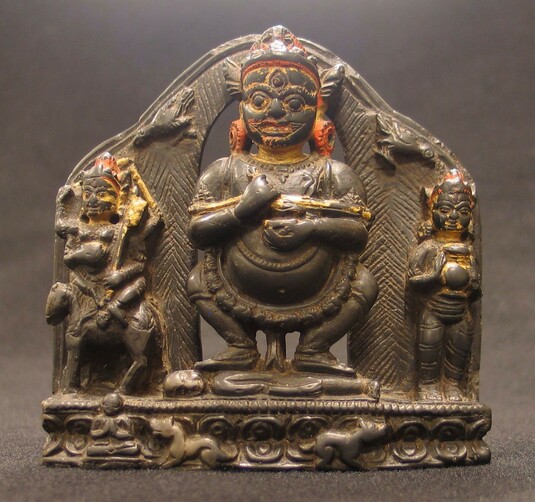
Item: Mahakala (Buddhist Protector) - Panjarnata (Lord of the Pavilion)
| Origin Location | Tibet |
|---|---|
| Date Range | 1300 - 1399 |
| Lineages | Sakya and Buddhist |
| Material | Stone |
| Collection | Rubin Museum of Art |
Panjarnata Mahakala (Tibetan: gur gyi gon po. English: Great Black One, Lord of the Pavilion). At the left side is Shri Devi with four hands riding a donkey. At the right side is the mother, Ekajati, holding a vase. Panjarnata Mahakala is most commonly found in configurations of Eight Deities, Three Deities or Solitary.
"The Great Vajra Mahakala, blazing, with one face, two hands, in the right a curved knife and left a skullcup filled with blood, held above and below the heart. Held across the middle of the two arms is the 'Gandhi of Emanation;' with three eyes, bared fangs, yellow hair flowing upward, a crown of five dry human skulls and a necklace of fifty fresh, blood-dripping. [He is] adorned with six bone ornaments and snakes, with a lower garment of tiger skin, flowing with penants and streamers of various silks; dwarfish and thick, in a posture standing above a corpse."
"Ekajati, with a body blue in colour, one face, two hands holding a nectar filled vase to the heart, wearing an upper garment of white silk fabric and a lower garment of tiger skin. The hair is tied in one braid hanging to the left; in a fierce aspect."
"Glorious Goddess, Mistress of the Desire Realm, riding a donkey with a white patch on the legs. With a body blue-black in colour, [she has] one face and four hands. The first right hand holds a sword, second a skullcup filled with blood. The first left holds a spear, the second a trident. With a crown of five dry human skulls, a necklace of fifty fresh and six bone ornaments, an elephant hide as an upper garment and a rakshasa hide as a lower garment - the lower garment with a buckle. The Lord of Nagas is tied as a girdle. Possessing three eyes, a stiff human corpse in the mouth, bared fangs, the right ear adorned with a poisonous snake and the left a lion. On the body, arranged in clumps, are drops of blood, clots of mold and ashes of the dead; [appearing] very emaciated." (Konchog Lhundrub, 1497-1557)."
The different traditions of Panjarnata Mahakala generally descend from Rinchen Zangpo down to Mal Lotsawa. The solitary aspect is an exception to this and belongs to the Sakya Margapala Tradition and descends from Virupa to Pandita Gayadhara and then to the Tibetan teachers of the Sakya Tradition. The solitary aspect is also found in the Sanskrit compilation text Sadhanasamuchaya.
Jeff Watt, 5-2006
Mahakala: Panjarnata, Lord of the Pavilion (Main Page)
Collection of Rubin Museum of Art: Sculpture (Gallery 2)
Art History: Medium, Sculpture - Stone
Mahakala: Panjarnata Masterworks (Sculpture)
Collection of RMA: Best of Collection 2
Mahakala: Panjarnata (Sculpture)
Mahakala: Panjarnata, Three Deity
Sculpture: Black Stone (Himalayan: Tibet, Nepal)
Collection of Rubin Museum of Art: Mahakala Sculpture Masterworks


